YUAN JIN
1.Urban Memory



Advisor Heinrich Hermann, Francesca Liuni, Xiaochuan Yu,Wolfgang Rudorf, Nick Haus Heywood
Abstract
The question of how to renovate the Beijing City Wall Ruins Park raises issues that engage exhibition, architectural, landscape, and urban design, not to mention cultural relics protection. It demands that we consider our attitude towards history. The walls and towers that used to surround the city have disappeared over years of changes and demolition. Except for the Zhengyangmen Tower and Deshengmen Tower, only a fragment exists: a section of Ming Dynasty wall in the southeast corner of the inner city.
The length of the project site is about 1.5km, which includes the wall fragment. By using the tools of exhibition design, I reactivate the old city wall and the spirit of the place. In my opinion, such a project is of great cultural significance in the process of Beijing's urban transformation. The area surrounding the wall is the threshold for the transformation of Beijing's old city and the outside world. The corner building of Dongbianmen is a landmark even before you enter Beijing station by train. From the perspective of history, it is the key area that can reflect the past development of Beijing city, as well as the development at
present and in the future.

“In fact, all the ancient big cities are like generous old grandmothers, who show the children a big world that is hard to find, and the children just grow up happily in their loving arms.”
For me, it is the interpretation of places, such as the memory, materials, people's lives and possibilities. In these elements, it records rich historical aspects. However, these elements are gradually disappearing in such a corner of the city that is under the charge of different administrative regions and national departments. In view of it, my problem lies in how to reweave these elements into the changing urban texture of Beijing and how to use events to weave various activities to this place. In planning and design, architects are more willing to wake up the memory and show the level of history instead of reconstructing the city wall and making fake history, who are more willing to leave all kinds of possibilities for the future instead of adding permanent structure to the city wall, and are more willing to let the charm of history itself show naturally here instead of making a beautiful landscape.
The exhibition renovation of the Ming City Wall ruins not only transformed the original exhibition facilities, let people better understand this historical monument, but also let this historical monument be integrated into the lives of contemporary people. Different exhibition facilities serve people and the ruins. It can be said that the exhibition facility is the link between the ruins and people. So how to better establish this bond and how to maximize good relationships have become the main problem solved in this project.
Story about Beijing city wall
The circumference of the inner city wall is 24 kilometers. It is roughly square. Since the north and south walls have been moved away from their original positions, the east and west walls are slightly longer. The northwest part is missing vertices. The inner city of Beijing has been under siege many times. For example, the Yihetuan movement and the Eight Nations Alliance broke out in the Qing Dynasty. With the exception of the League of Eight, all other countries have been successfully defended.
The Outer city walls had four corner guard towers and seven gate towers. The outside of the wall was covered with blocks averaging a metre in width. Most of the larger blocks were installed during the Ming dynasty and the smaller ones during the Qing dynasty. The blocks on the interior surface averaged 0.7 metres. The Outer city walls had an average height of 6 to 7 metres. The wall was 10 to 11 metres wide at the top and 11 to 15 metres wide at the base. The western sections were the narrowest, averaging only 4.5 metres at the top and 7.8 metres at the base.

There are 11 gates in the metropolis, including three on the east, south and west, and two on the north. From the north to the south, the three gates are: Guangxi Gate, Chongren Gate, and Qihua Gate; from the north to the south, the three gates are: Suqing Gate, Heyi Gate, and Pingzemen; among the three gates on the south: Lizhengmen is in the middle , Shuncheng Gate is in the west, civilization gate is in the east; of the two gates in the north: Jiande Gate is in the west, and Anzhen Gate is in the east.
In 1949, the capital of the People's Republic of China was Beijing. Since then, the central government has decided that the city walls of Beijing will hinder the construction of modern transportation and is not conducive to urban planning, and it has decided to demolish them completely. The removal of Beijing's city walls has taken a long time. In the 1950s, the outer city walls were completely demolished; the inner city walls were successively demolished from 1953, and during the Cultural Revolution, Beijing built a combatready subway.

The Demise of the wall 1900

The fire took place and caused a fire, and the tower was destroyed.

The hole the British opened in the Chongwenmen for the railway.

After going through various historical periods,
especially after the construction of the Beijing subway, there are very few city gates and walls left in Beijing
Design Introduction
The cities are always destroyed before they are protected. the planning and protection of Beijing City, the capital city of China, is the same. We cannot just regret that the ancient cities are gone. We must also enhance our awareness of protecting the cities and not let the vicious circle of "destroy before protection" continue.
Site InformationBeijing Mingcheng Wall Ruins Park is located north of Chongwenmen East Street, west to the east of Chongwenmen Old Site, east to the southeast corner of Beijing ’s inner city, and north to the south of the east exit of Beijing Station East Street. And the ground of the southeast corner tower of the inner city is 3.3 kilometers, and the green area is 12.2 millimeters. The existing city wall ruins are 1.5 kilometers away and belong to the inner city wall of Beijing. They were built during the Jiajing period of the Ming Dynasty.



In the 1970s, it was thought that the construction of the Beijing Railway Station and the city wall became the dormitory of the workers. The people built a temporary dormitory by the city wall, and lived for seven years, causing a second damage to the city wall.


In 2000s, In order to restore the original appearance of the city wall, the government spent 700 million yuan to relocate the workers ’dormitory. Due to the large amount of funds spent on relocation, it is very unfavorable for the restoration of the city wall ruins. It is currently restored to a simple city park.



Thesis ProbeThe question of how to renovate the Beijing City Wall Ruins Park raises issues that engage exhibition, architectural, landscape, and urban design.The length of the project site is about 1.5km, which includes the wall fragment. The exhibition renovation of the Ming City Wall ruins not only transforms the original exhibition facilities and let people better understand this historical monument, but also let this historical monument be integrated into the lives of contemporary people.
Through the above picture, we can analyze the sub-buildings, proportions, proportions, relationship with the surrounding environment, surrounding trees, and the impact of different light or high temperature on the environment.The building on the right is located inside the museum, which will better protect the building, but the feeling it brings is different.but the feeling it brings is different. The displacement of an architecture from its original site causes a loss of context
Displaying Architecture
Authenticity / Spirit of Place


Heritage ProtectionEmphasize true historical remains
The focus of protection is historical style
Ensure the inheritance and function of culture
The focus of protection is historical style
Ensure the inheritance and function of culture
Tourists / Residents needs
Understand the past
Understand now
Feel the Site
Participate in local activities
Provide rest and gathering places
Provide convenience
Understand the past
Understand now
Feel the Site
Participate in local activities
Provide rest and gathering places
Provide convenience
Design Principles After conducted research and registration, it became clear that the architectural project needed to frame the area for the visitors. Since there are no artefacts to be displayed in the exhibition, the scenery itself should be on display, and the architectural input should underline this. Corten Steel is chosen to match up with the history of the walls, but also to explain the contrast between the constant and the changing in the area. Because our original intention was to protect historical sites. Instead of creating new landmarks



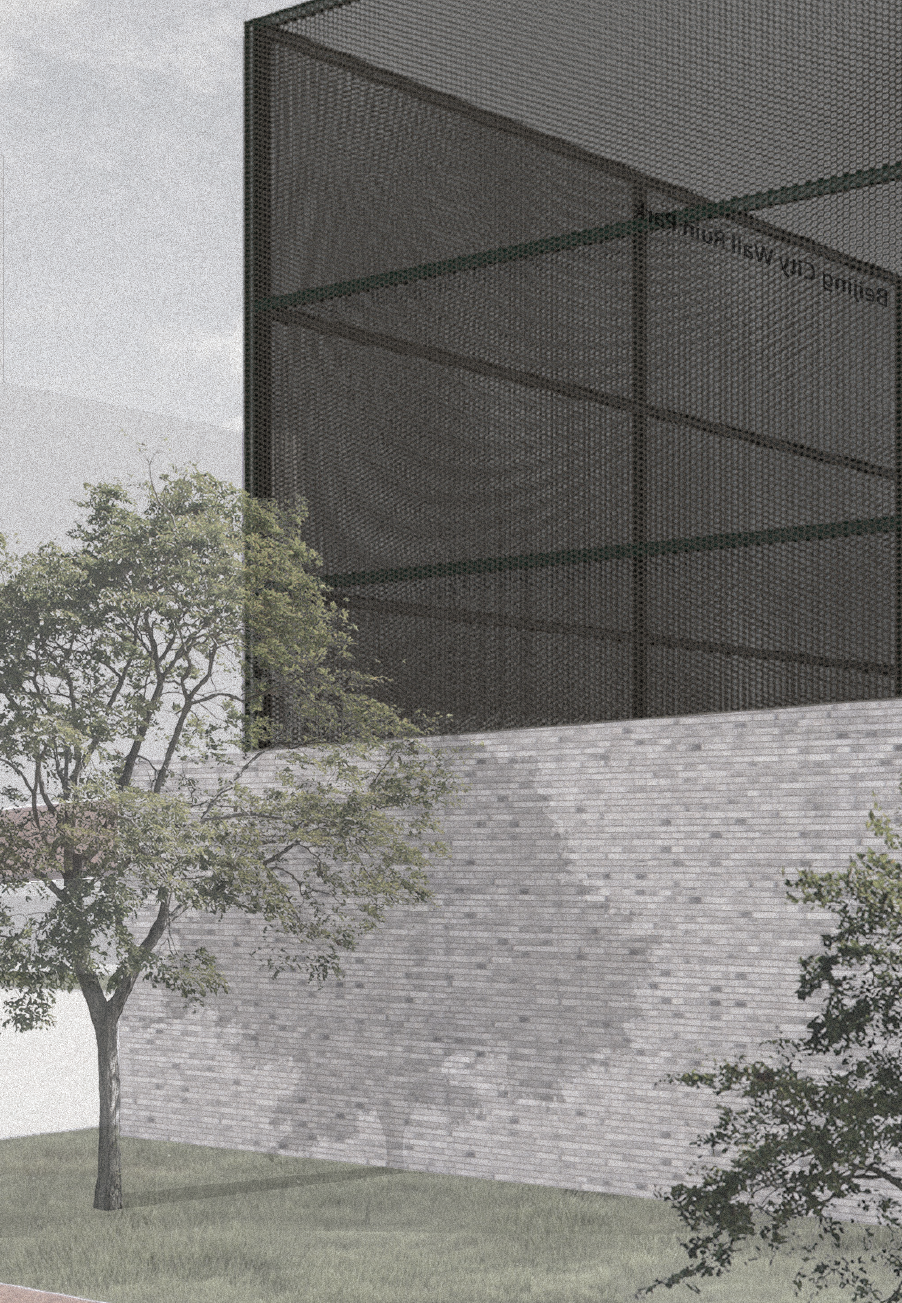
Punched Aluminum Plate

Corten Steel
Transparent Tempered Glass




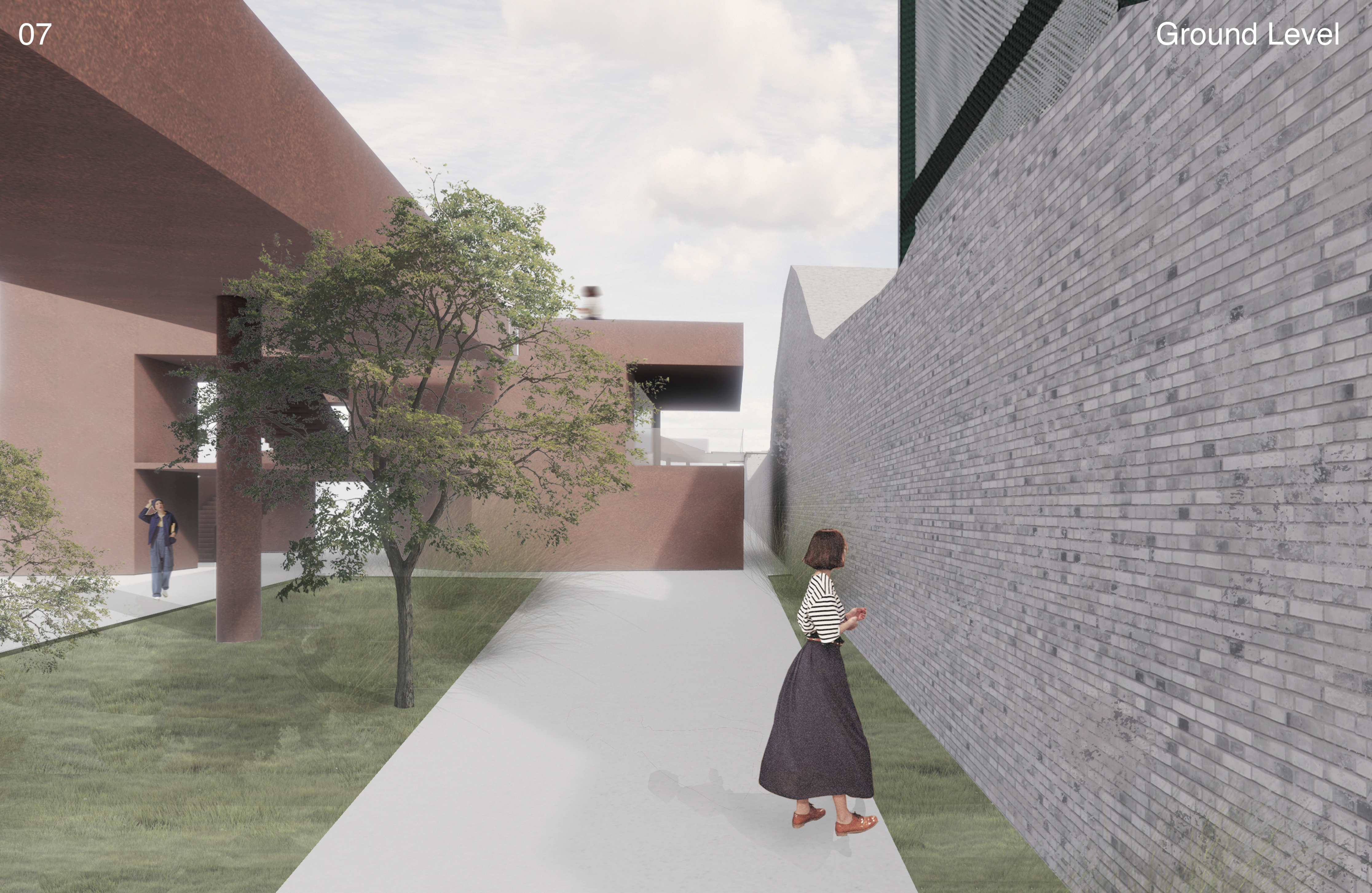








2.Industrial Ghost



Advance Studio / Site: Philadelphia, US / Dec 2019
Advisor Jongwan Kwon
Industrial Ghost is an adaptive reuse architecture, infrastructure and landscape project exploring obsolete spaces left behind in the wake of deindustrialization and accelerated urbanism. Philadelphia had been the center of the nation’s industrial production until its transition to a service economy, and the project investigates the future of a disused railway track, “The Cut”, and grain elevator, “The Granary”, in the contemporary post-industrialism world. The project addresses social and spatial challenge through envisioning new models for co-working and co-living space engaging the sharing economy.
“The Cut” transforms the obsolete railway track into a community park and network that connects the diverse cultural, educational, industrial and residential areas of Center City, Philadelphia. Inspired by the narrow and deep characteristic of the site, the park engages the surrounding through circulatory paths that diverge and converge to create unique experiences. Lastly, these paths grow in both width and height as they flow through the bustling city.
Site Analysis
“The Cut” and “The Granary”, 2019
Abandoned railway ruins bring safety hazards to the city
“The Granary”, 2019
Although it has been abandoned for decades, there are still grains falling from the granary
Industrial Activity and Social Culture
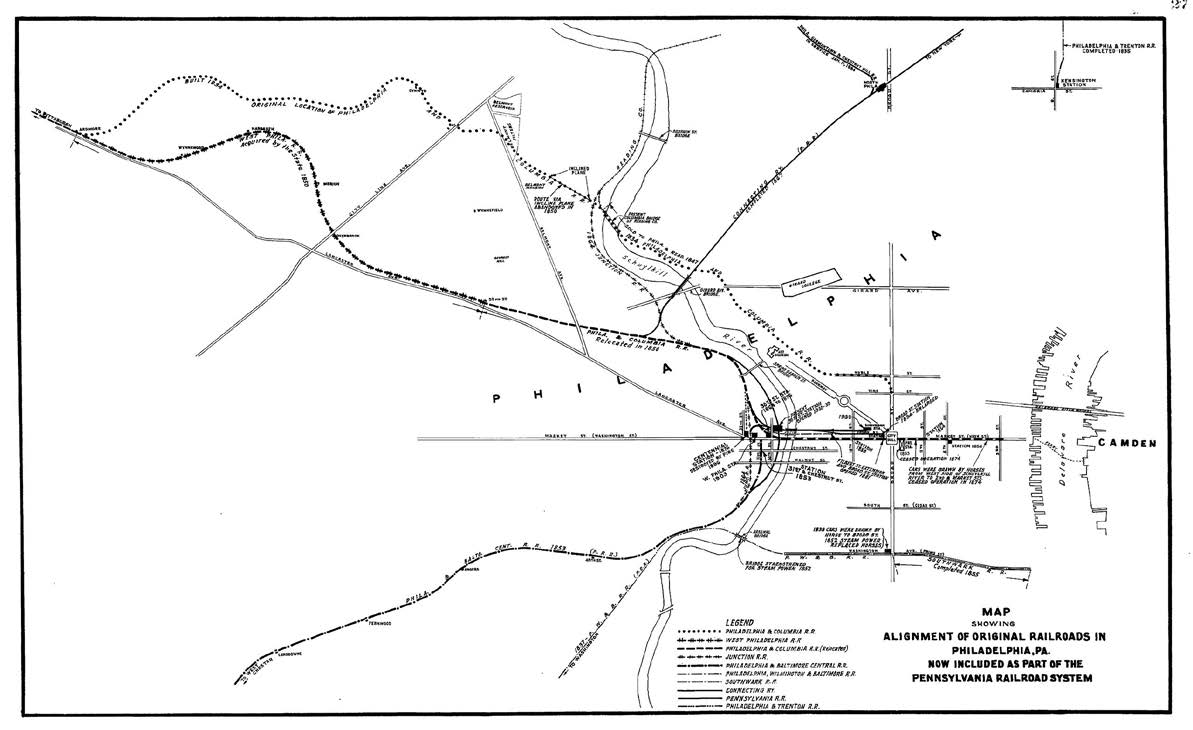





The research aims to focus on the industrial activity and social culture that associate with the project. We analyzed the industrial types around our site in the past; commuity condition; grain transportation and storage; grain elevator category; concrete urban grain elevator operation; social life of workers. From researching, we’re forming a basic understanding of how the builidng functioned and how people lived in the area.
Grain Elevator Component


Head House
Head house is the isolate structure on top of the building. After grain is emptied from truck or train, they were carried along the leg by a continuous belt with flat backed buckets attached up to the head house. Grain is weighed and sorted in the headhouse and then goes down to the distributing floor.
Distribution Floor
Located just above the main bin structure, the distributing floor is easily identified from the exterior by the large windows which span across its length. These windows provide ventilation to an area prone to grain dust explosions.
Bins
The bins comprise the storage area of the elevator. The most important features of a bin are its shape, wall configuration, and bottom slope. Concrete elevator bins are usually circular, though other forms can be found. The bottom o a bin may be either flat or hoppered. While a flat-bottomed bin is difficult to empty thoroughly, a hoppered-bottomed bin is sloped to facilitate the movement of grain.
Work Floor
The work floor is located below the storage bins at ground level and connects the elevator to the train, barge, and truck loading areas. Like the distributing floor, the work floor is an open space with windows on all sides. It is distinguished, however, by the presence of the hoppered bottoms of the bins on its ceiling and the immense
Part 1. Railway Ruins to garden Community Garden
Through visits and investigations, we found that our site is located in a historical district. According to the research, we can see that there are many museums, churches, libraries, convention centers and other cultural buildings in the surrounding area. It is the center of urban activities and a large number of activities are held here every year.
![]()
![]()
![]()
![]()
![]()
![]()



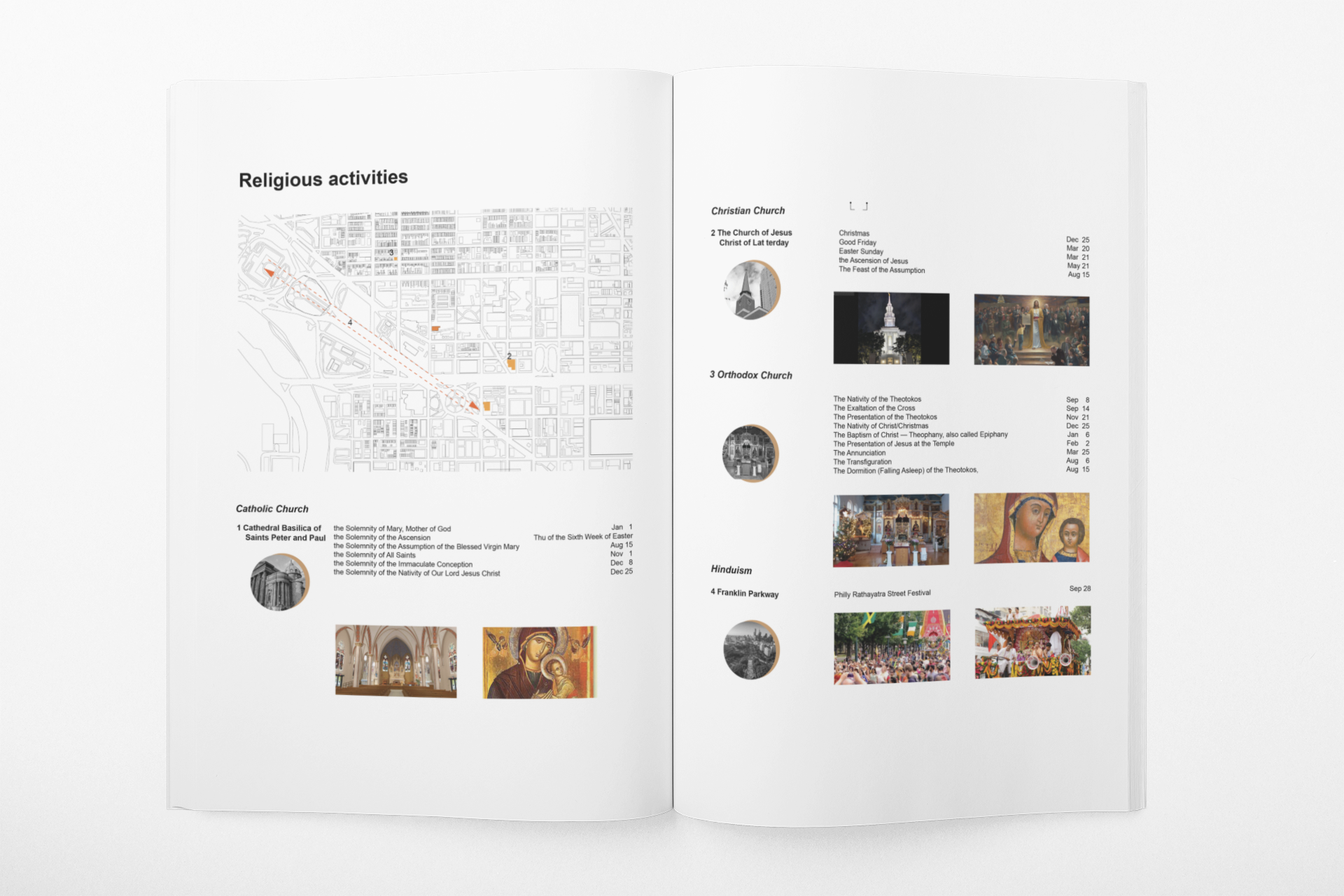


Although our site is currently in a semi-abandoned state, there are four bridges that will pass over the railway site and are important local transportation routes.
I think a good way to transform the industrial heritage is to transform and continue its original functions. So we are trying to transform the railway ruins into a community garden, where people can receive a piece of their own round land for planting.The underground part can be used as an educational space for lighting planting. These round ramps are connected to the four main urban roads and people can pass freely. The space below the ramp becomes a public facility in the city, and at the same time some shop spaces are set up where people can open a market.
As a continuation of the community garden, the lower floor is designed as an urban market, where dining, food sales, cooking courses and other activities are provided in this area. At the same time, the large steps generated by the height difference also connect the different areas of the height difference.
I think a good way to transform the industrial heritage is to transform and continue its original functions. So we are trying to transform the railway ruins into a community garden, where people can receive a piece of their own round land for planting.The underground part can be used as an educational space for lighting planting. These round ramps are connected to the four main urban roads and people can pass freely. The space below the ramp becomes a public facility in the city, and at the same time some shop spaces are set up where people can open a market.
As a continuation of the community garden, the lower floor is designed as an urban market, where dining, food sales, cooking courses and other activities are provided in this area. At the same time, the large steps generated by the height difference also connect the different areas of the height difference.


Part 2. Silos to Share Space
Combining the analysis of the surrounding area and the continuation of the railway ruins, I started the transformation of the silo. During the transformation, the function of the space included supermarkets, shared living, shared office and other spaces. Through the analysis of the surrounding potential customers and user needs, I formulated the principle of "small share and big share" as shown in the figure below.









I researched and communicated the method and proportion of the aluminum plate punching on the facade. After repeated proofing and confirmation, I chose the punched aluminum plate to wrap the window part of the building. The punching style strives to echo the original building facade. The semi-permeable covering and lighting are used to “reduce” the entire building, and the light “rhythm” and the jumping volume division welcome the traffic outside the room.
The translucent material not only protects the privacy of the residents, but also maintains the original form of the historic building. From a distance, the building will not cause disharmony due to the large number of newly opened windows.
All the private rooms are covered with punched aluminum plate on the outside, but in the shared space I chose to open windows, as a continuation, the balcony of the shared space is set as a planting area. Because of the large area of the shared space, sunlight extends into the shared space through the large balcony.




3. Sound of Years
Interior Design / Exhibition Design / Boston, Massachusetts /June 2020
Advisor:Francesca Liuni
The project is located at Harvard University. This project is the first complete exhibition design I have done, including the selection of exhibits, interior space design, interior structure design, display cabinet design, installation design, lighting design, exhibition catalog design, etc. Since I had very little contact with exhibition projects before, it was a challenge for me.
In fact, this space is not an exhibition space. It is a transitional space between the student study room and the teacher's office. It is a square box. The height of the room is ten meters, and the width is only five meters, so I decided to use vertical space to create a split-level indoor space with different heights through different heights to get more exhibition space.
During the field visit, I found that many students are resting in the corridors, because the entire building is academic, and there is no transitional space outside the restaurant on the first floor. I hope to combine the exhibition with the leisure space by browsing the Harvard University Museum In the collection, I found many exhibits related to music. I think music is a good way to relax, so I set the theme of the exhibition as music. The exhibits are music players of different ages, even with a history of more than 100 years. At the same time as the exhibition, I matched the music and rest space of the same period, so that students and teachers can have a relaxing space during rest.
Site:The Richard A. and Susan F. Smith Campus Center, Boston,MA






The main point of the design of this space is how to use the height change to provide more possibilities for our exhibition. In addition to connecting the two floors, the teachers and students can easily go upstairs and downstairs. As a permanent exhibition, The most important thing is how to make this space best play its role and how to activate the surrounding space.
New Plan & Section



Exploded View
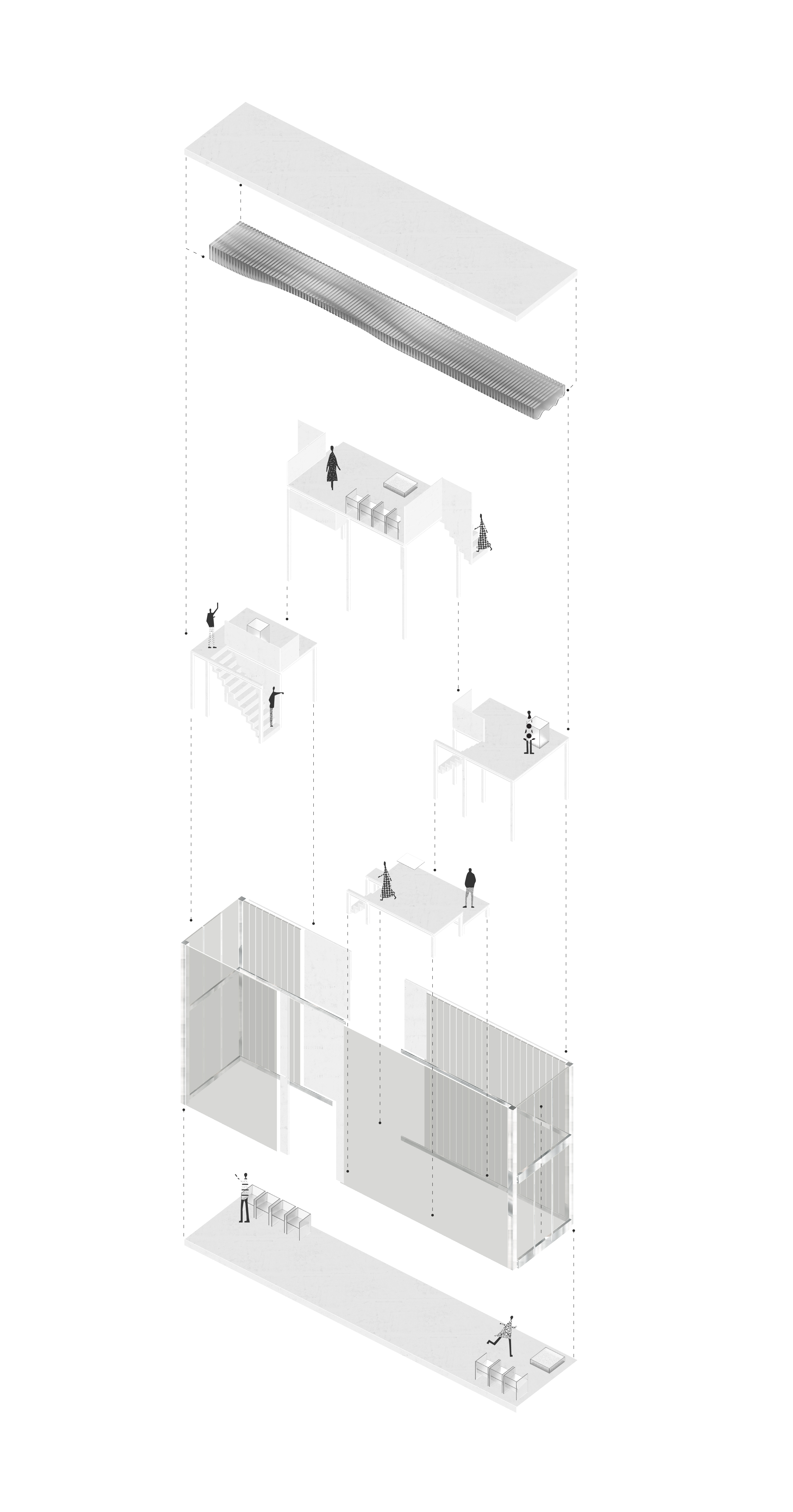
Showcase Design






4. City Museum
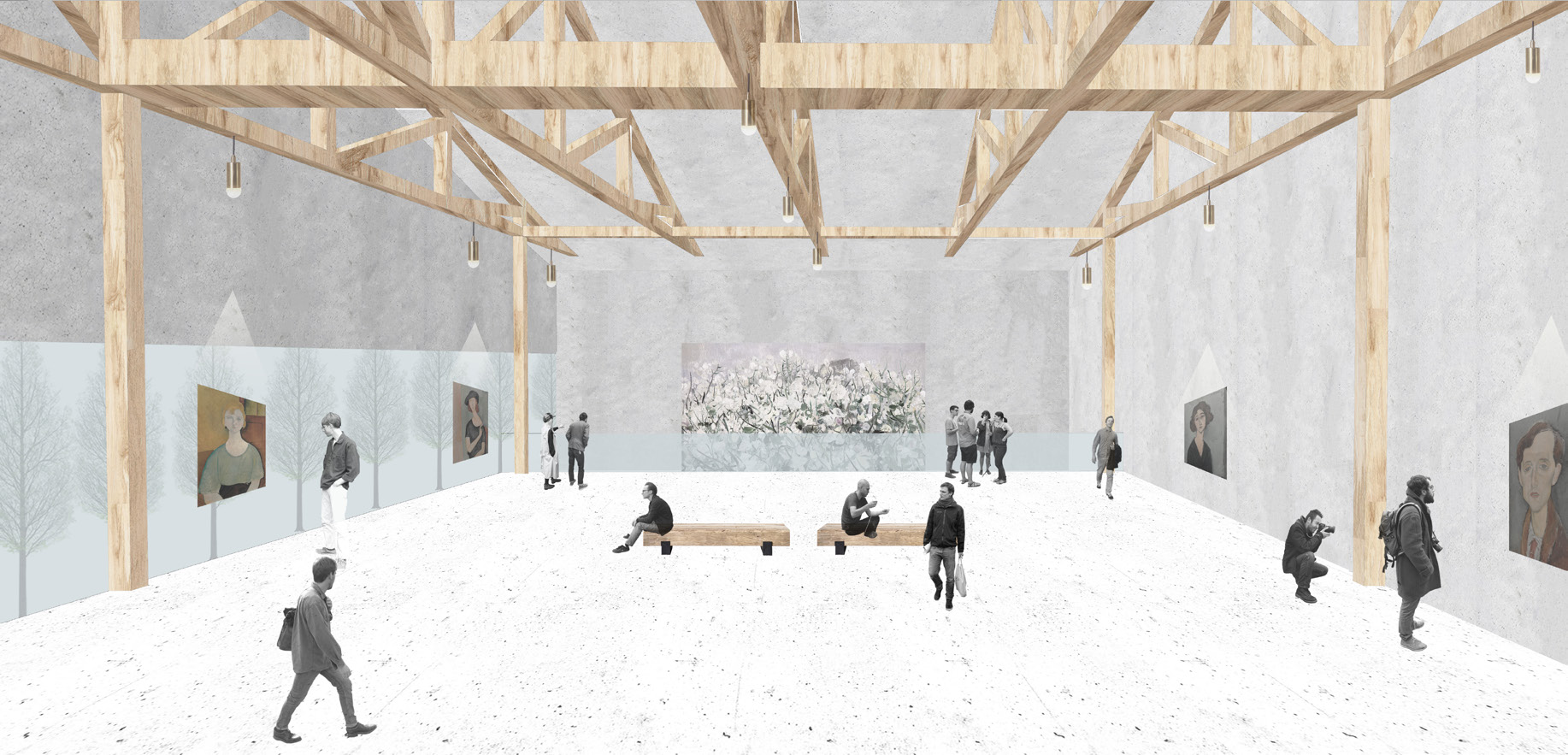

Bachelor thesis / Site: Beizhen Beijing, China /June 2017
Advisor Jianmin Yang, Xichen Que
The project is located in the open space on the south side of Beizhen Temple of Beizhen, so people started to think carefully about how to handle the relationship between the building and the surrounding historic districts. In such a historic cultural area, more emphasis should be placed on the relationship between new buildings and old ones. In addition, as cultural center of the city, this program not only serves the function of a museum, but also provides urban citizens with a gathering place. So the designer hope this museum is neither serious nor solemn. It should be an architecture that is free and respectful of history, so that people can develop a relaxed feeling here. Because the building's surroundings are planned as Cultural Squares, the Museum can function as a sub-center here. I hope that people will gather freely where it becomes part of local life.
Although Beizhen is a famous historical and cultural city with numerous historical sites and historical relics, including not only small objects but many giant stone Buddha statues. Therefore, while considering indoor exhibitions, I also consider the use of the combination of the landscape and the show.
History Research


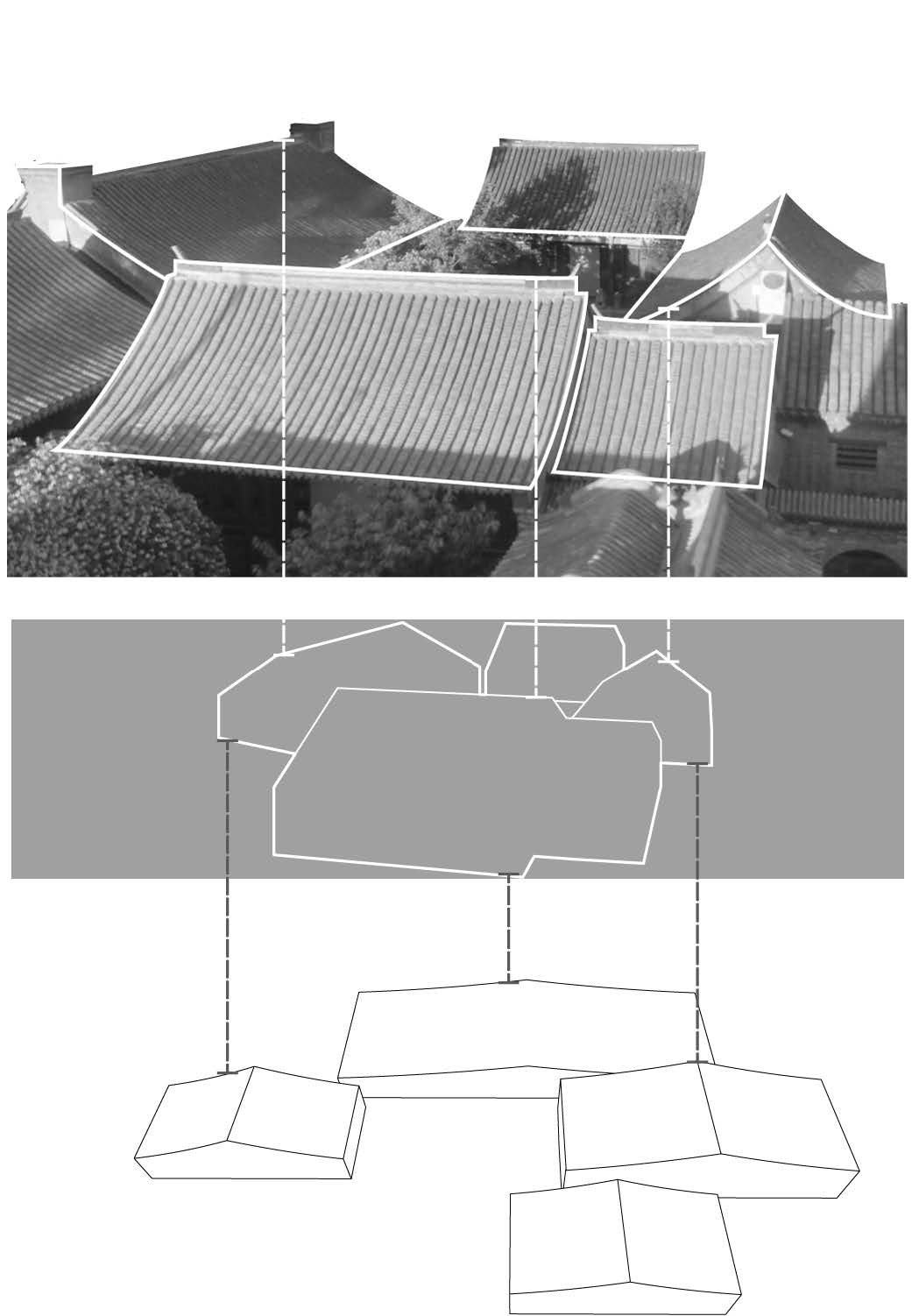

I choose to control the volume of the building and to distribute each space from a lateral perspective, which can also contributes to the enclosed space. In the architectural form, I choose the traditional Chinese sloping roof, which is usually the same height as the rooftops of houses, museums and roofs in northern China. From a distance, it looks like a cascade of mountains thus narrowing the sense of distance.
The traditional museum has a strong fixed space planning, such as the outdoor space as a rest area with exhibits located all indoors. When it comes to planning exhibition space, I think more should be considered in terms of the characteristics of exhibits. There are many giant stone tablets and stone carvings in Beizhen. So I have considered the combination of outdoor display space and interior one through which exhibits can better display their own charms. Besides, I choose glass box as the form of the passageway. Not only can it increase the interaction between the building and the outdoors considering lighting issues, it can also remind people that this is a rest area, suggesting the end of the last exhibition hall.
Architecture





We have lived in apartments for a long time and I long for the experience of living in a traditional courtyard. I hope this building can give such a feeling of relaxation so that people will be attracted by the friendly image from the beginning, and the vision and body can follow the meandering ground unconsciously into the museum's interior. People can choose either the sinking courtyard in order to visit the outdoor exhibition, or the first building before the quiet pool through the calm water to filter out the feelings of the outside world, reaching the first floor of the exhibition hall.
In the courtyard people can choose to sit in the courtyard under the tree to chat, or feed the fish in the pool, through the huge curtain wall you can see the interior art and people walking indoors. Everyone's feelings and ideas are different. In this building people have the right to choose freely, rather than follow the architect's idea of a person’s completing the process.
Interior





The traditional museum has a strong fixed space planning, such as the outdoor space as a rest area with exhibits located all indoors. When it comes to planning exhibition space, I think more should be considered in terms of the characteristics of exhibits. There are many giant stone tablets and stone carvings in Beizhen. So I have considered the combination of outdoor display space and interior one through which exhibits can better display their own charms. Besides, I choose glass box as the form of the passageway. Not only can it increase the interaction between the building and the outdoors considering lighting issues, it can also remind people that this is a rest area, suggesting the end of the last exhibition hall.
This museum is supposed to provide local and foreign visitors with a place to talk to nature, trees, water and arts through real materials and pure space. This plain and simple idea will be spread to more visitors through my project.





